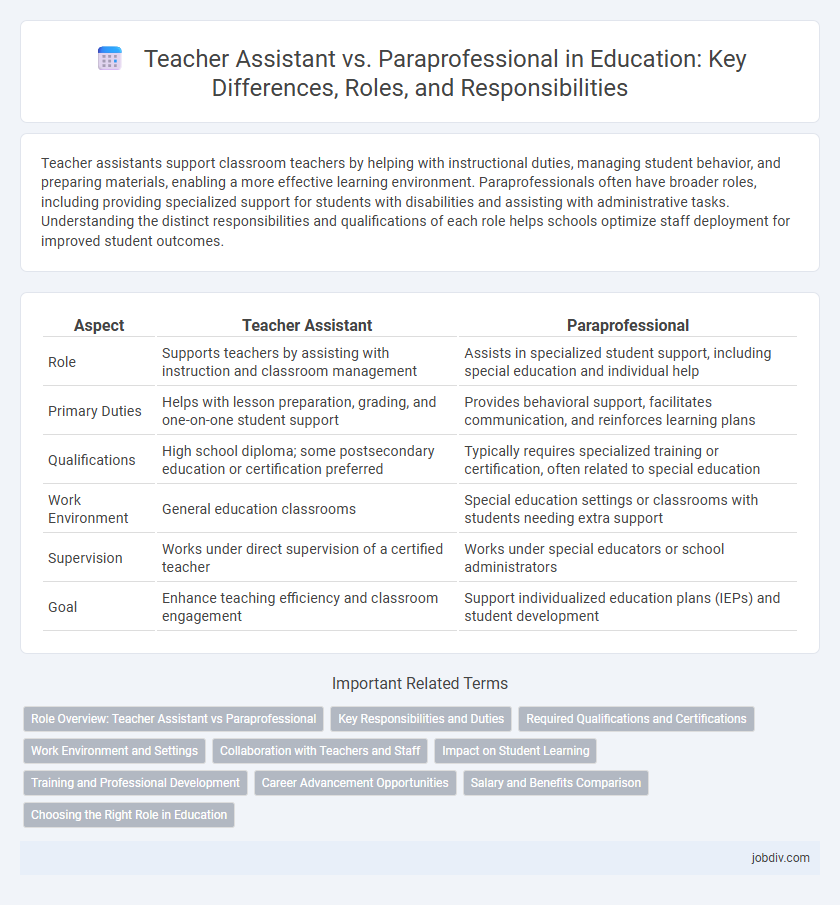Teacher assistants support classroom teachers by helping with instructional duties, managing student behavior, and preparing materials, enabling a more effective learning environment. Paraprofessionals often have broader roles, including providing specialized support for students with disabilities and assisting with administrative tasks. Understanding the distinct responsibilities and qualifications of each role helps schools optimize staff deployment for improved student outcomes.
Table of Comparison
| Aspect | Teacher Assistant | Paraprofessional |
|---|---|---|
| Role | Supports teachers by assisting with instruction and classroom management | Assists in specialized student support, including special education and individual help |
| Primary Duties | Helps with lesson preparation, grading, and one-on-one student support | Provides behavioral support, facilitates communication, and reinforces learning plans |
| Qualifications | High school diploma; some postsecondary education or certification preferred | Typically requires specialized training or certification, often related to special education |
| Work Environment | General education classrooms | Special education settings or classrooms with students needing extra support |
| Supervision | Works under direct supervision of a certified teacher | Works under special educators or school administrators |
| Goal | Enhance teaching efficiency and classroom engagement | Support individualized education plans (IEPs) and student development |
Role Overview: Teacher Assistant vs Paraprofessional
Teacher assistants primarily support lead teachers by managing classroom activities, providing individualized student support, and preparing instructional materials. Paraprofessionals often take on broader responsibilities that include specialized assistance for students with disabilities, behavior management, and facilitating communication between students and teachers. Both roles enhance instructional effectiveness but differ in scope and specialization within educational settings.
Key Responsibilities and Duties
Teacher assistants support lead teachers by preparing instructional materials, managing classroom behavior, and assisting with student assessments. Paraprofessionals perform similar duties but often have specialized roles such as providing individualized support to students with disabilities or reinforcing lessons under teacher guidance. Both positions involve fostering a positive learning environment and enhancing student engagement through direct interaction and administrative assistance.
Required Qualifications and Certifications
Teacher assistants typically require at least a high school diploma and may need an associate degree or some college coursework, along with specialized training or certification based on state regulations. Paraprofessionals often must complete formal certification programs such as the ParaPro Assessment or meet state-mandated qualifications including specific coursework in education or child development. Both roles prioritize understanding of instructional support and child safety, but paraprofessionals usually hold more stringent certification requirements to work in specialized educational settings.
Work Environment and Settings
Teacher assistants typically work directly in classrooms alongside certified teachers, supporting instructional activities and managing student behavior in public and private school settings. Paraprofessionals often serve in a broader range of environments, including special education classrooms, resource rooms, and inclusive settings, providing specialized support to students with disabilities. Both roles require collaboration with teachers and school staff, but paraprofessionals may also engage in non-instructional duties such as clerical tasks and student supervision outside the classroom.
Collaboration with Teachers and Staff
Teacher assistants collaborate closely with teachers by supporting lesson plan implementation and providing direct student assistance, enhancing classroom instruction quality. Paraprofessionals often take on specialized roles, such as working with students who have disabilities, requiring coordination with special educators and therapists to tailor support services. Effective collaboration between teachers, teacher assistants, and paraprofessionals promotes a cohesive learning environment, ensuring consistent communication and shared educational goals.
Impact on Student Learning
Teacher assistants often have specialized training in instructional strategies, enabling them to provide targeted academic support that enhances student comprehension and engagement. Paraprofessionals typically assist with classroom management and routine tasks, indirectly contributing to a positive learning environment but with less direct influence on individualized instruction. Research indicates that classrooms with well-trained teacher assistants see measurable improvements in student achievement and behavior outcomes compared to those relying primarily on paraprofessionals.
Training and Professional Development
Teacher assistants typically receive targeted training in instructional support and classroom management, while paraprofessionals often undergo broader professional development covering diverse educational needs, including special education and behavioral interventions. Ongoing certification programs and workshops enhance the skills of both roles, with paraprofessionals frequently requiring specialized credentials to support students with disabilities. Effective training ensures that teacher assistants and paraprofessionals contribute meaningfully to student learning outcomes by aligning their development with current educational standards.
Career Advancement Opportunities
Teacher assistants often have clearer pathways for career advancement with options to become certified teachers or specialized educators through additional coursework and certifications. Paraprofessionals typically support classroom activities and may advance by gaining specialized skills or earning credentials that qualify them for roles such as behavioral specialists or instructional coordinators. Both roles benefit from professional development, but teacher assistants generally experience broader opportunities for upward mobility within the education sector.
Salary and Benefits Comparison
Teacher assistants typically earn higher salaries than paraprofessionals due to their additional responsibilities in supporting classroom instruction and managing student activities. Benefits for both roles often include health insurance, retirement plans, and paid leave; however, teacher assistants may receive enhanced benefits packages tied to their qualification levels and union membership. Salary ranges for teacher assistants usually fall between $28,000 and $40,000 annually, while paraprofessionals often earn between $22,000 and $35,000 depending on district and state funding.
Choosing the Right Role in Education
Choosing between a Teacher Assistant and a Paraprofessional depends on the specific responsibilities and qualifications required in the educational setting. Teacher Assistants primarily support classroom instruction and student engagement under direct teacher supervision, while Paraprofessionals often have specialized roles such as working with students with disabilities or managing administrative tasks. Evaluating the needs of the school environment, certification requirements, and the level of student support needed is crucial for selecting the right role to enhance educational outcomes.
Teacher Assistant vs Paraprofessional Infographic

 jobdiv.com
jobdiv.com